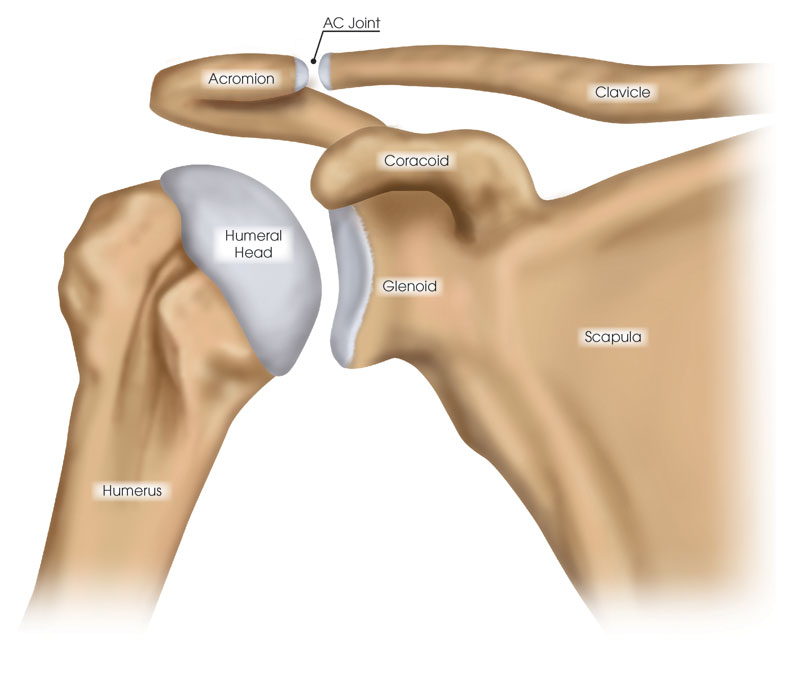 Online appointment scheduling is easy, convenient anytime on any device
Online appointment scheduling is easy, convenient anytime on any device
Shoulder[shohl-der] – Anatomy. The part of each side of the body in humans, at the top of the trunk, extending from each side of the base of the neck to the region where the arm articulates with the trunk.
 The shoulder possesses a remarkable range of motion making it one of the most mobile and important joints in your body. Whether you are throwing a baseball, working overhead or performing everyday tasks of reaching and carrying, your shoulder motion is critical to this high level of function. Unfortunately, this increased mobility and structural complexity makes your shoulders susceptible to injuries that can be quite limiting and disabling.
The shoulder possesses a remarkable range of motion making it one of the most mobile and important joints in your body. Whether you are throwing a baseball, working overhead or performing everyday tasks of reaching and carrying, your shoulder motion is critical to this high level of function. Unfortunately, this increased mobility and structural complexity makes your shoulders susceptible to injuries that can be quite limiting and disabling.
The shoulder consists of three bones, three main joints and an articulation between the scapula (shoulder blade) and thorax (chest):
The joint surfaces of the shoulder are covered with a thin, but robust, layer of cartilage over the ends of the humeral head (ball) and glenoid (socket) that allows the shoulder surfaces to articulate, move smoothly–almost frictionless and painlessly along each other. The cartilage lacks a blood supply. It gets nutrition from joint fluid. Without a blood supply, and because of its relatively less active cellular makeup, cartilage cannot maintain or repair itself. The cartilage is extremely durable, but in time with “wear and tear” or following injury, it breaks down, fails and leads to cartilage damage and eventually symptomatic (pain, stiffness, swelling) arthritis (failure of this protective joint surface).
The shoulder has a labrum or thickening of firm soft-tissue attached to the rim of the glenoid (socket). It deepens the socket to increase stability, bears load and serves as the attachment point for shoulder joint ligaments that run between the upper arm bone and the bony glenoid (socket). Ligaments are strong soft-tissue bands that connect bones at a joint, provide stability and proper limits to motion. The labrum and ligaments may be torn if forces cause the humeral head (ball) to abruptly shift in the glenoid (socket) such as during a shoulder dislocation. Shoulder ligaments get their names from the bones to which they connect and include the superior glenohumeral ligament (SGHL), middle glenohumeral ligament (MGHL) and the inferior glenohumeral ligament (IGHL) with important anterior and posterior bands. There also are other important ligaments in the shoulder including the acromioclavicular, coracoclavicular and the sternoclavicular ligaments.
The shoulder has several muscles that help it move with proper coordination and strength to accomplish tasks ranging from simple reaching, to high level overhead athletic maneuvers. Muscles are like loaded active springs. They attach to bones across joints by different shaped rope- or band-like tendons to exert their action and cause movement. The rotator cuff is a deep, core group of four muscles. They keep the humeral head (ball) centered on the glenoid (socket) while the pectoralis major, deltoid and latissimus dorsi (the big muscle movers of the arm) create pulling and pushing forces that would otherwise shift the humeral head out of the glenoid. Even with simple reaching—out and away from your body—the rotator cuff must generate forces equal to almost 80 persent of your body weight to keep the humeral head centered in the glenoid. Even greater forces are needed during overhead throwing or strenuous lifting movements. These tremendous forces can cause tears in the tendon portion of the rotator cuff and result in pain and arm/shoulder limitations. The long head of the biceps muscle that attaches to the top of the glenoid through the superior (top of the) labrum also can be injured and cause pain. Additionally, muscles control the scapula (shoulder blade) or base of the shoulder joint which can be affected by injury and overuse producing shoulder pain and limitations.
A shoulder injury—either by accident or overuse—can occur in more than one area because of the shoulder’s anatomic complexity and surrounding muscles, tendons, ligaments, labrum and cartilage. Systemic illness or disease also can affect your shoulder; however, overuse is a common cause of an injury which typically results from:
Most people know immediately when they injure their shoulder because of pain, lack of mobility and inability to participate in daily activities. If you experience any of these symptoms, do not put off making an appointment to be examined and treated. Delay and neglect are the biggest reasons small and correctable injuries become larger and more difficult to treat—even resulting in a permanent disability.
Dr. Steven Chudik is renowned for his arthroscopic shoulder expertise and innovative shoulder replacement procedures that reduce shoulder surgical trauma, speed recovery and yield excellent outcomes.
Arthroscopy is a surgical procedure performed through small incisions that involves looking inside a joint with a small camera to diagnose and repair shoulder injuries.
Arthroscopy has been performed since the 1970s. From the Greek words “arthro” (joint) and “skopein” (to look), the word literally means to look in the joint. Dr. Chudik is pioneer in arthroscopic shoulder and knee surgery. He developed several innovative arthroscopic orthopaedic procedures, instruments and implant solutions because he saw a need and invented a way to improve techniques that result in better outcomes for his patients.
Compared to open surgical procedures, arthroscopy minimizes injury to the surrounding soft-tissues, and reduces postoperative pain, scar tissue and recovery time, allowing the quickest and most complete recovery of function, mobility, and performance.
Regardless if you have arthroscopic or open surgery, both have a risk for complications. Consequently, a decision to undergo surgery should never be taken lightly and trust in your surgeon’s expertise and dedication to helping you through the entire surgical experience is imperative.
The following are surgery procedures Dr. Chudik routinely performs, as well as the special arthroscopic surgical techniques he developed.
After sitting at a desk all day managing insurance investments, Scott Edwards looks forward to his recreational activities of running and playing hockey. However, Edwards is not just a casual participant. He plays on several hockey clubs, as well as pick-up games when teams need a strong forward. During a...
Read MoreIf you ask Greg Beggs, patent lawyer, gardener, golfer, former Downers Grove Village Zoning Board and Plan Commission member, Downers Grove Chamber of Commerce enthusiast and grandfather of 10, success throughout his life came because he was in the right place at the right time. His legal career began in a modest way.
Read More